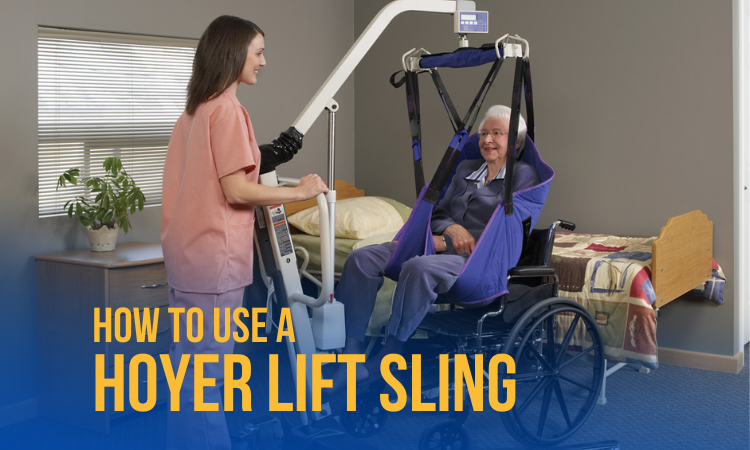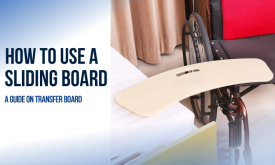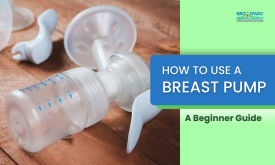Aiding the mobility needs of a patient can help improve the patient's lifestyle and add to a better and safer experience for the patient. While many advancements in the medical field allow better recovery, a wide variety of medical supply ranges help speed up the healing process. Hoyer lift sling is one of the medical devices that aid in lifting the patient and transferring them from one place to another without putting pressure on their body.
Hoyer sling wraps the patient and supports them completely while the lift machine helps pick the patient to a height and then carries them smoothly from one place to another. While many models and types of hoyer slings and lifts exist, understanding which works best for the patient can allow you to make wise decisions. Here are the different types and how to use the hoyer lift sling for faster recovery.
Types of Hoyer Lift Sling
Full Body Hoyer Lift Sling
The most common type of hoyer lift sling is the full-body sling. It generally lacks head support but provides a firm grip to lift the patient easily. It has 4 or 6 points for lifting the patient and can easily bear a weight of around 600 lbs. With some variations, a full-body commode sling helps the patient easily use the toilet without embarrassment.
Bariatric Hoyer Sling for Patient Lift
A specially designed bariatric hoyer sling works best for people with excessive weight. The sling is compatible with the bariatric lift, making it comfortable for patients with higher body mass to fit easily and get transferred from one location to another.
Disposable Hoyer Lift Sling
Sometimes, slings are required to lift the patient for bathroom activities, and reusing can be unhygienic. Disposable hoyer lift slings are perfect for showering, bathing, or pooling activities, allowing clean and hygienic practice. The disposable slings are breathable, but the weight capacity is less than regular lift slings. It comes with and without head support.
Leg Hoyer Sling
Patients with heavy arms and legs or restricted mobility of limbs require extra support. A leg sling adds better support to lift the patient and ensure complete health and safety. The back and seat of the leg hoyer sling are separate, which provides divided support.
Seat Hoyer Sling
Seat sling, or U sling, as you call it, is suitable for patients who can sit easily but have lower body mobility difficulties. It comes with and without head support but has a lower weight-bearing capacity.
Hoyer Advance E
The hoyer Advance E is one of the most sought-after hoyer slings on the market due to its lightweight frame, tapered legs and folding capabilities. The lift can handle a wide range of transfers and can be moved around easily. The lift is also propelled by a motor, which reduces the strain on the caregiver.
Full Back Slings
A Full back hoyer sling is ideal for those who have spinal cord injuries or less upper body strength. It offers neck, head, and shoulder support for a safe transfer from a bed, power chair, or transport chair. In this type of skin, the patient is in a sitting position during transfer and angled slightly behind to prevent falls.
U-shaped slings
Like a full back hoyer sling, U-shaped slings also transfer the patient while seated but don't support the neck and head. The reverse arms wrap around the underside of the thighs while the wider curve supports the spine. U slings are best suited for those with neck strength who need assistance maneuvering between chairs or from a hospital bed to a chair and vice versa. U-shaped slings are available in both 4-point and 6-point varieties.
Bathing Hoyer Slings
Bathing hoyer slings are designed to assist caregivers in bathing patients. The patient is supported by a sling either in the chair or bathtub. Some bath support slings also feature a nylon draining mesh and an optional head support.
Different Lift for Hoyer Lift Sling
Portable Hydraulic Lift
A portable Hydraulic Hoyer sling lift is attached to different slings, allowing the patient to be relocated easily without caregivers needing to bear and support the patient. The lift is electric and provides convenient transfer through its design.
Bariatric Patient Lift
Those with a higher weight require a heavy-duty lift to ensure there is no risk of fall or injury. The bariatric lift has a wide cradle for comfortable seating and rotates 360 degrees for easy operations. It has a huge body for bearing weight without getting pressured. The battery-operated lift comes with an emergency button, which converts the electric lift to the manual for patient safety.
Ceiling Hoyer Lift
While most hoyer lifts are free-standing, a ceiling hoyer lift is attached to the ceiling. The track is mounted on the ceiling, which is ideal for small rooms since it saves floor space. However, a ceiling lift can cost more than other types of hoyer lifts.
Power Hoyer Lift
Power or electric hoyer lifts can be plugged into a wall socket or powered by batteries. That is why they are the easiest type of hoyer lift to operate. You just have to push a button to raise or lower the lift.
Manual Hoyer Lift
A manual hoyer lift, also known as a hydraulic lift, is powered by a hydraulic pump that is easy to use but more complicated than simply pressing a button.
Sit Stand Hoyer Lift
A sit-stand hoyer lift is a cross between a power and manual lift. It secures the patient as they move from a seated to a standing position. It is generally recommended for those who have the strength to partially operate the lift mechanism
How to Use a Hoyer Lift Sling
Step 1: Examine the Lift
Ensure the lift wheels are tightly attached and locked in position. Some lifts have an adjustable base that can be widened for a more secure transfer. Also, ensure the swivel bar at the top is connected and the sling is hooked properly.
Step 2: Check the Safety of the Sling
Examine the sling for tears or holes and ensure the sling is securely attached to the hooks on the swivel bar. Also, make sure the sling can hold the patient's weight.
Step 3: Place the Hoyer Lift Sling
The next step is to place the hoyer lift sling below the patient to attach it to the lift easily. Placing the sling is the most crucial step and requires precision to ensure patient safety. To start with, position the patient in the center of the bed. Now, roll the patient on one side, place the hoyer sling and adjust to ensure half of the side sets correctly. Now rotate the patient on the other side and slowly pull the other half end to spread the sling below the patient.
Step 4: Position the Lift
After placing the hoyer sling for a patient lift, position the lift. Ensure that the lift is close to the bed and all the points are securely attached to the lift. Before attaching the sling to the lift, lock the wheels so that the lift doesn't move from place and there is no harm caused while lifting the patient. To attach the sling to the lift, raise the patient bed to some degree, which makes it easy to attach the sling to the lift.
Step 5: Lift the Patient
Carefully use the lift buttons to raise the patient from the bed. Keep the motion slow to ensure the patient is comfortable and doesn't feel pain.
Step 6: Move the Patient
After lifting the patient, unlock the wheels and transfer the patient through the lift from one place to another. Go slow and have a caregiver along to ensure extra safety.
Step 7: Transfer
Once you reach the desired surface, slowly bring down the patient on the bed, wheelchair, or a comfortable surface. Unlock the points and release the hoyer sling from the lift. With the same rolling movement, remove the sling below the patient's bed.
How to Choose the Best Hoyer Lift?
Weight capacity
The most important consideration when choosing patient lifting equipment is weight capacity because if the lift fails, it can cause injuries to both the patient and caregiver. It is also important to remember that not every hoyer lift is suitable for bariatric patients. Many manufacturers recommend an electric hoyer lift for patients who exceed a certain weight so that caregivers do not hurt themselves during the lifting process.
Safety
When choosing hoyer slings for patient lifts, it is important to consider their reliability and safety. Check for accreditations from reputable organizations like the FDA.
Material
Look for patient lift slings made from durable and comfortable materials. It should withstand regular wear and tear and ensure patient comfort during transfer.
Versatility
Some hoyer lift slings are more versatile than others. Look for slings that can be used with different types of lifts and transfer aids. This will reduce the number of lift slings that need to be purchased.
Sling size
Hoyer lift slings are available in different sizes, such as small, medium, large, and extra-large. The size of the sling will depend on the weight of the patient. While lighter patients will require a small size, heavier patients will require a large size. There are also bariatric slings available that can easily support patients weighing less than 1OOO pounds.
Understanding the functioning of the hoyer lift sling is crucial for the patient's safety. Someone who has restricted mobility requires extra care and support. Using uncompromised quality that offers complete safety while using becomes a must. hoyer sling for patient lift at Broadway Medical Supply offers a smooth transfer of patients with a secure and trusted design. With a range of medical supplies for different needs, you can access top-notch healthcare quality with a better living experience for patients.
Frequently Asked Questions (FAQs)
1. What Safety Measures Must Be Followed When Using the Hoyer Lift Sling?
Certain precautions need to be followed while using a hoyer sling for patient lifts.
- Avoid pushing or pulling on the lift boom, as doing so can cause it to tip over.
- While lifting the patient, ensure they are centered over the base and facing the caregiver.
- To lower the patient's chances of falling, spread the adjustable base lifters as wide as possible before lifting.
- Only use the hoyer lift to move the patient.
2. How Do I Choose a Sling Size?
Finding the right sling size can be difficult; however, knowing the patient's body measurements can be helpful while choosing hoyer slings for patient lifts. Measure the torso, seat width, leg length and your reach to get a better understanding of which sling to choose.
3. How Do You Measure A Patient's Lift Sling?
To correctly measure a patient lift sling, measure the patient's height, waist, shoulder thigh, or refer to the weight recommendation of the product. Another thing you can do is to recheck the fitting after the patient is placed in it. It is sized properly if the lower edge is at the patient's coccyx, the leg straps are under the thighs, and the shoulders are of the same height as the sling
4. Can One Person Operate a Hoyer Lift?
Even though a single person can successfully operate the lift, physicians generally recommend multiple caregivers use a hoyer lift. One to operate the machinery and another to protect the patient from injury. Sometimes, the lift may tip over with the patient in it. The second caregiver can prevent injury to the patient in such instances.








